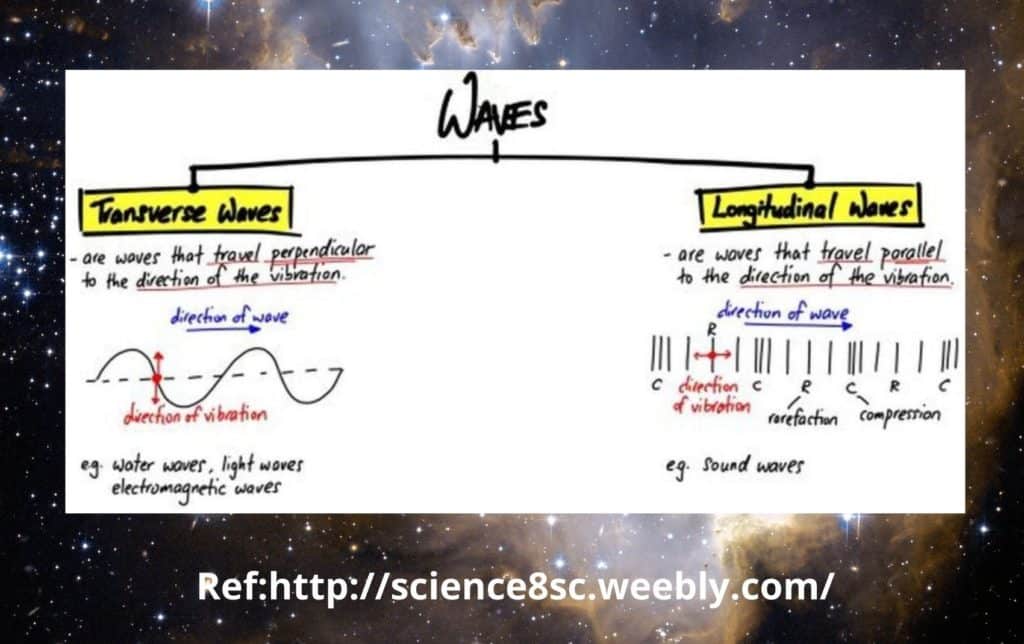Compression waves are also called longitudinal waves. Longitudinal waves are mechanical waves in which the vibration of the particles takes place in the same direction as that of the wave.
In a stretched spring, a longitudinal wave can be created by compressing a small region of the coils and then releasing the compressed region. As a result, the disturbance will propagate as a longitudinal pulse.
In a longitudinal wave, compression is a region where the medium is compressed, and rarefaction is a region where the medium is spread out. Examples of compression waves include sound waves, ultrasound waves, and seismic P-waves.

In compression waves, the vibration of the medium is parallel to the direction the wave travels and the displacement of the medium is in the same (or opposite) direction of the wave propagation. The amplitude of a compressional wave is proportional to how tightly the medium is compressed at the compression. The larger the amplitude of the wave and the more energy it carries, the denser the medium is at the compression. The closer the coils are together in compression, the further apart they are in rarefaction.
A vacuum cannot support any wave that requires compression/rarefaction (such as sound) or shear between matter atoms or molecules, or a combination of these. These types of waves are known as longitudinal or transverse waves.
Sound waves are compression waves.
Table of Contents
Compression Waves Main Points
| Characteristic | Description |
|---|---|
| Definition | Compression waves, also known as longitudinal waves or pressure waves, are a type of mechanical wave in which particles in a medium vibrate back and forth in the same direction as the wave is traveling. |
| Motion | The motion of compression waves is characterized by areas of high pressure, known as compressions, and areas of low pressure, known as rarefactions. |
| Medium | Compression waves require a medium in order to propagate, as the wave travels by transferring energy from one particle to the next through a series of compressions and rarefactions. |
| Examples | Examples of compression waves include sound waves, seismic waves, and pressure waves in fluids such as water or air. |
| Speed | The speed of compression waves is determined by the properties of the medium, such as its density and elasticity, and is typically faster in solids than in liquids or gases. |
| Properties | Compression waves can be characterized by their wavelength, frequency, amplitude, and period, and can be affected by factors such as interference, reflection, and refraction. |
Properties Compression Waves
- Compression is a region in a longitudinal wave where the particles are closest together.
- A rarefaction is a region in a longitudinal wave where the particles are furthest apart.
- The wavelength of a longitudinal wave is the distance between two consecutive points that are in phase.
- The amplitude is the maximum displacement from a position of rest.
- The period of a wave is the time taken by the wave to move one wavelength.
- The frequency of a wave is the number of wavelengths per second.
- The speed of a longitudinal wave is defined as v=f⋅λ, where v is the speed in m/sec, f is the frequency in Hz and λ is wavelength in m.
What is compression in waves?
A compression wave (such as a sound wave) is propagated by the elastic compression of the medium. — called also compression wave.
A compression wave may be created by pushing and pulling the slinky horizontally. When these waves pass through a medium, they cause compression and rarefaction. Compressions are high-pressure areas where wave particles are close together.
Examples Of Compression Waves In Everyday Life
- Vibrating Tuning Fork
- Tsunami Waves
- Speaking on the mic
- vibrations in a guitar string
- a wave moving through a stretched-out slinky or spring
- An ocean wave
- seismic S-waves
What are compression and rarefaction?
In a longitudinal wave, compression is the region when the particles are closest together. A rarefaction is an area in a longitudinal wave where the particles are the furthest distant from one another.
Summary
- Compression waves are a type of mechanical wave that involves the back-and-forth vibration of particles in a medium.
- The motion of these waves is characterized by areas of high pressure, which are closely packed particles, and areas of low pressure, where particles are farther apart.
- They require a medium in which to propagate and can travel through solids, liquids, and gases.
- Some examples of compression waves include sound waves, seismic waves, and waves in fluids like water or air.
- The speed of the wave is dependent on the properties of the medium such as density and elasticity and can be characterized by the wavelength, frequency, amplitude, and period.
- They can interact with other waves through interference, reflection, and refraction.
- Attenuation, or the decrease in amplitude and intensity of these waves over distance, is influenced by factors such as absorption and scattering.
Multiple choice Questions
- Which of the following is a characteristic of compression waves?
a) They only travel through liquids.
b) They involve the back-and-forth vibration of particles.
c) They are a type of electromagnetic wave. d) They don’t require a medium to propagate.
Answer: b) They involve the back-and-forth vibration of particles.
- What determines the speed of a compression wave?
a) The frequency of the wave.
b) The wavelength of the wave.
c) The properties of the medium, such as density and elasticity.
d) The amplitude of the wave.
Answer: c) The properties of the medium, such as density and elasticity.
- Which of the following is an example of a compression wave?
a) Radio waves
b) X-rays
c) Seismic waves
d) Light waves
Answer: c) Seismic waves
- What is attenuation?
a) The increase in amplitude and intensity of a wave over distance.
b) The decrease in amplitude and intensity of a wave over distance.
c) The bending of a wave as it passes from one medium to another.
d) The interaction of two or more waves when they meet.
Answer: b) The decrease in amplitude and intensity of a wave over distance.
- What is the Doppler Effect?
a) The bending of a wave as it passes from one medium to another.
b) The interaction of two or more waves when they meet.
c) The apparent change in frequency of a wave due to the relative motion between the wave source and the observer.
d) The decrease in amplitude and intensity of a wave over distance.
Answer: c) The apparent change in frequency of a wave due to the relative motion between the wave source and the observer.
Frequently Asked Questions
- What is a compression wave?
A compression wave is a type of mechanical wave in which particles in a medium vibrate back and forth in the same direction as the wave is traveling. It is characterized by areas of high pressure, known as compressions, and areas of low pressure, known as rarefactions.
- What are some examples of compression waves?
Some examples of compression waves include sound waves, seismic waves, and pressure waves in fluids such as water or air.
- How do compression waves propagate?
Compression waves require a medium in order to propagate, as the wave travels by transferring energy from one particle to the next through a series of compressions and rarefactions.
- How does the speed of compression waves vary in different media?
The speed of compression waves is determined by the properties of the medium, such as its density and elasticity, and is typically faster in solids than in liquids or gases.
- How are compression waves affected by interference, reflection, and refraction?
Compression waves can be characterized by their wavelength, frequency, amplitude, and period, and can be affected by factors such as interference, reflection, and refraction. Interference occurs when two waves meet, reflection occurs when a wave bounces back from a surface, and refraction occurs when a wave changes direction as it passes from one medium to another.
More Interesting Topics
- BCl3 Lewis Structure in four simple steps - November 1, 2023
- PH3 Lewis Structure in four simple steps - October 8, 2023
- PF3 Lewis structure in four simple steps - September 24, 2023



